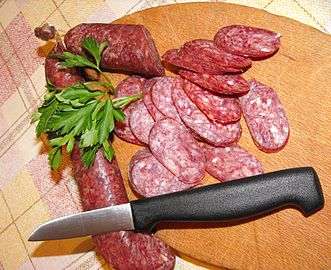Sujuk
Sujuk is a dry, spicy sausage which is eaten from the Balkans to the Middle East and Central Asia.
 Turkish parmak sucuk | |
| Alternative names | Sucuk, sudjuk, sudžuk, sudzhuk |
|---|---|
| Type | Sausage |
| Region or state | Middle East, Central Asia, Balkans |
| Main ingredients | Ground meat (usually beef), cumin, garlic, salt, red pepper |
Name
The Turkish name sucuk has been adopted largely unmodified by other languages in the region, including Gagauz: sucuk; Albanian: suxhuk; Arabic: سجق, romanized: sujuq; Armenian: սուջուխ, suǰux; Bosnian sudžuka; Bulgarian: суджук, sudzhuk; Greek: σουτζούκι, sutzúki; Macedonian: суџук, sudžuk; Romanian: sugiuc; Russian: суджук, sudzhuk; Serbian/Croatian sudžuk /cyџyk.
Cognate names are also present in other Turkic languages, e.g. Kazakh: шұжық, shujyq; Kyrgyz: чучук, chuchuk.[1][2]
Preparation, varieties
There was considerable variety in sausage preparation during the Middle Ages. Though offal was never used in Ottoman sausages, it was a common ingredient in the many varieties of sausage prepared throughout Medieval Romania.[3]
Sujuk consists of ground meat (usually beef or lamb, but horse meat is often used in Kazakhstan and Kyrgyzstan).[4][5][6]
Dishes prepared with sujuk
Thin slices of sujuk can be pan-fried in a bit of butter, while larger pieces may be grilled. Sucuklu yumurta, which literally means "eggs with sujuk", is commonly served as a Turkish breakfast dish.[7] Sucuklu yumurta is a simple dish of fried eggs cooked together with sujuk,[8] but sujuk may also be added to other egg dishes like menemen (which is similar to shakshouka but with scrambled eggs instead of poached).[9][10]
Sujuk can be added to many dishes including fava bean stew (kuru fasulye), filled phyllo dough pastries (burek) and as a topping for pizza or pide.[11][12]
 Eggs with sujuk
Eggs with sujuk- Bread with sujuk
See also
- Kazy
- Lukanka
- Makhan, a horsemeat sausage
- Soutzoukakia, spicy meatballs in sauce whose name means literally "little sucuk"
- Salami
References
- Hasan Eren (1999), Türk Dilinin Etimolojik Sözlüğü, Ankara, p. 376
- Csato, Eva Agnes; Csató, Éva Ágnes; Isaksson, Bo; Jahani, Carina (2005). Linguistic Convergence and Areal Diffusion: Case Studies from Iranian, Semitic and Turkic. Psychology Press. ISBN 978-0-415-30804-5.
- Angela Jianu; Violeta Barbu, eds. (2018-06-14). Earthly Delights. Brill. p. 115. ISBN 978-90-04-36754-8.
- John Gregory-Smith (2018). Turkish Delights: Stunning regional recipes from the Bosphorus to the Black Sea. UK: Hachette. ISBN 978-08-57-83596-3.
- Н. Н. Пальгов; М. Ш. Ярмухамедов (1970). Казахстан (in Russian). Москва: Мысль. p. 138.
- Виктор Кадыров (2019). Кыргызстан. Традиции и обычаи киргизов (in Russian). Москва: Litres. p. 53. ISBN 978-50-41-88963-0.
- Emina, Seb; Eggs, Malcolm (2013-03-14). The Breakfast Bible. Bloomsbury Publishing. ISBN 978-1-4088-3990-4.
- "Sucuklu Yumurta Nasıl Yapılır?". Sabah. Retrieved 2018-07-17.
- Khong, Rachel; Peach, Lucky (2017). Lucky Peach All about Eggs. Crown Publishing Group. ISBN 978-0-8041-8775-6.
- Rutherford, Tristan; Tomasetti, Kathryn (2011). National Geographic Traveler: Istanbul & Western Turkey. National Geographic Books. ISBN 978-1-4262-0708-2.
- Sarlık, E. Emel; Sarlık, Mehmet (1995). IV. Afyonkarahisar Araştırmaları Sempozyumu Bildirileri: 29-30 Eylül 1995, Afyonkarahisar. Hazer Ofset Matbaacılık Gazetecilik Limited Şti.
- Pelin Karahan'la Nefis Tariflerundefined (Director). Sucuklu Pide Tarifi. Event occurs at 869 seconds. Retrieved 2018-07-17.

.jpg)
